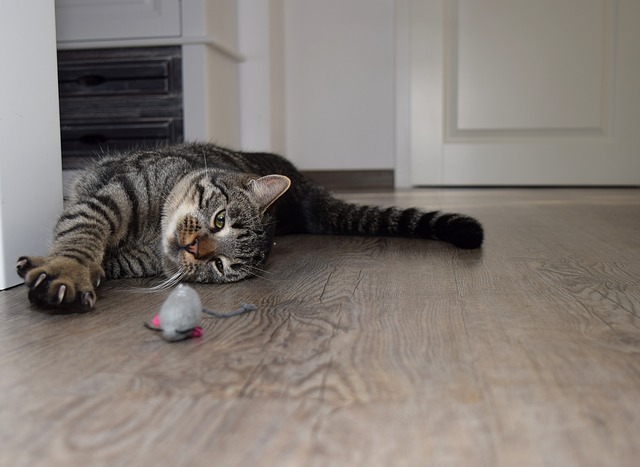
the scientific study of pet nutrition by veterinary nutrition specialists and experts.
Puzzle Feeders for Cats: Dogs Shouldn’t Have All the Fun!

Cats are the most commonly kept pet in the in the United States. Cat owners are advised to keep their cats indoors for a variety of reasons including safety, health, and to avoid wildlife predation. But many owners are rightfully concerned about their cat’s mental health when they are kept inside, unable to express their natural behaviors. Their closest wild ancestor, the African wildcat, gives us an idea of the behavioral needs of our feline friends. In the wild, cats work for their food several times a day by hunting and only about half of their hunts are successful.
In contrast, house cats often have free access to as much food as they want straight from a bowl. Acquiring food takes no effort and they often eat more calories than they burn, which can lead to medical issues such as obesity, diabetes, and joint problems. Indoor living situations and easy access to food can also lead to boredom and frustration due to the lack of stimulation, resulting in behavioral problems. Common behavioral problems reported by owners of indoor cats include aggression, attention seeking, over grooming, and urinary problems (such as inappropriate urination).
The Indoor Pet Initiative from the Ohio State University provides a wealth of important information about how environmental enrichment benefits an indoor cat’s health and well-being. One easy environmental enrichment activity for cats is a food puzzle, which forces cats to work for their food. Food puzzles can be made from any object that can hold food. They can be made to hold both wet food and dry food, though most commercial puzzles are designed for dry food or treats. Mobile puzzles can be rolled and pushed around until food falls out. These can be easily made at home by cutting holes in toilet paper rolls, water bottles, or egg cartons or can be purchased commercially. The hole sizes can be increased or decreased to make the puzzle easier or harder for the cat. There are also stationary puzzles composed of large, sturdy bases with holes, cups, channels, etc in which the cat must fish out food with their paws.
Implementing food puzzles for the first time takes some time and planning. Cats can be very particular about which food puzzles they will use, which will likely come as no surprise to anyone that owns a cat. You may consider food puzzles that are clear with many holes so that the cat can see and smell the food inside. Make sure to split the total daily amount of food between the feeder and in the cat’s normal bowl until they figure out the puzzle feeder. If the cat needs more motivation, some food can be sprinkled around the puzzle so the cat will associate the puzzle with food.
If the cat’s regular food does not motivate them to use the puzzle, using some of their treat allowance along with their regular food may stimulate their interest.
Once your cat is accustomed to using a puzzle to obtain food, you can make it harder by adding less food, so they have to work harder to get the food out. Switching to nontransparent puzzles and/or puzzles with smaller and fewer holes will make them work harder for food. Once they have become advanced foragers, all their meals can be fed from the food puzzles.
In multiple-cat households, cats can be placed in different rooms for meal time, each with their own puzzle. Or, a puzzle feeder can be a great tool if one of your cats eats much quicker than the other as a puzzle feeder given to the fast eater can slow them down at meal time and avoid stealing meals between pets. Try them out – there are many types and some trial and error will help you find the ones that work best for your cat(s)!
Written in conjunction with veterinary student Sasha Santiago.
Want to read more information on feeding your pet?
Subscribe to always know when we add new material!
Recommended Posts

Can Diet Help With My Dog’s Seizures?
January 18, 2024

The Most Popular Holiday Foods…That Your Pet Should Avoid!
December 08, 2023

Veterinarian Recommended Pet Foods: What You Need to Know
November 05, 2023

